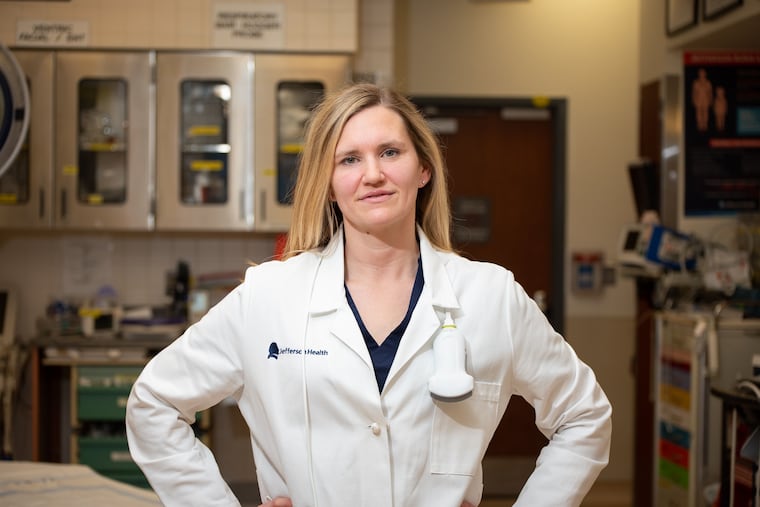ER doctor: I fear healthcare worker shortages as COVID-19 surges this winter | Expert Opinion
Healthcare workers are increasingly needed to homeschool or provide childcare, quarantine, or suffering from illness, or moral injury.

I pulled the phone from my scrub pocket and held my breath as I read the latest COVID-19 alert from my daughter’s daycare center confirming another positive case. This was the fourth in three days, after zero cases since reopening in June. The night prior, regional ER colleagues reached out to me noting an abrupt influx of patients with concern for COVID-19. The message was loud and clear: this virus is resurging here with a vengeance.
Last Wednesday as I tucked my daughter into bed, the emails with positives continued to pop up. And then the inevitable but dreaded notification: school closure. They noted that instead of being linked to other cases by exposure, new positives were unrelated — no one was sure where they were exposed.
This situation is exactly what Philadelphia Department of Public Health’s website “high risk of community transmission” is referencing, and why the new Safer at Home restrictions were put into place, along with others across Pennsylvania, New Jersey, and Delaware. Untraced and unchecked COVID-19 circulation is happening in our community. If not adhering to masking and distancing, this virus gains ground very quickly.
» READ MORE: ER doc: Stay home, Philly. COVID isn’t over yet | Expert Opinion
My winter concern has been escalating as I watch the United States track toward 200,000 daily cases. Contrary to the resources and support I saw mobilized by our federal government as a healthcare worker in Liberia during the West Africa Ebola response, my experience fighting this pandemic on home soil in the United States has been quite the opposite. While I’m lucky to be leading the Emergency Medicine COVID-19 response at Jefferson Health, a system that I have witnessed go to all lengths to protect patients and staff, many other hospitals continue to be challenged with the availability of PPE and other critical supplies. Issues of testing capacity and turnaround time, and poor centralized public health messaging, continue to plague and frustrate the national response. And now, we have reached a concerning regional inflection point. New daily COVID-19 case numbers in Pennsylvania are exceeding 6,000 — tripling our spring surge heights.
Healthcare workers feel these skyrocketing numbers. Nationally, more people than ever are hospitalized with COVID-19. ERs, hospitals, and ICUs are filling with patients needing oxygen and respiratory support, in addition to previously healthy adults presenting with strokes or pulmonary embolisms from COVID-related clotting.
There are not sidelined teams ready to deploy to hot spots like spring outbreaks because now there is significant simultaneous case burden in hospitals across the entire country. Healthcare workers are increasingly needed to homeschool or provide childcare, quarantining, or suffering from illness, or moral injury.
I worry that in this next surge, healthcare workers will be the most scarce resource.
» READ MORE: Frontline workers on how their lives have changed since the coronavirus hit — and what scares them
Data indicates my daughter is likely to have mild symptoms if she contracts COVID-19 — but she is three years old and cannot isolate alone. So, like all the other parents at my daycare and across America facing quarantine, I will miss work. Despite staying safe over the last eight months wearing an N-95 and face shield for all ER shifts, despite having safely worked as an Ebola treatment unit hot zone trainer, I now find myself, with asthma and a prior blood clot, at risk for getting ill in my own home.
A bright light has appeared with COVID-19 vaccine data over the last few weeks. Both candidates have reported efficacy as promising as we could have hoped. However, while awaiting large-scale vaccination over the next few months, patience remains a key weapon in managing this pandemic.
Many lives will be unnecessarily lost over the winter if we do not take action NOW. Cold weather driving people indoors and the coming holidays raise serious concern for superspreader events. Based on how much the virus is currently circulating, a multigenerational Thanksgiving gathering can have a catastrophic impact. In addition to sparing your family tree, the essential workers you depend on — sanitation workers, grocery store clerks, social workers, hospital techs, nurses, physicians — all rely on your social sacrifices now to stop the spread and flatten the curve so we can continue to serve you.
» READ MORE: COVID has changed how I will practice medicine, forever | Expert Opinion
We must commit to taking the precautions that work — masking, distancing, hand washing, tight social circles, avoiding nonessential activities, isolating and testing (even if only mild symptoms), and complying with quarantine guidelines when exposed. This will save lives, help prioritize safely having kids in school, and help hospitals keep pace with the virus. We already see a major impact of the secondary pandemic caused by delay or avoidance of medical care, one that cannot afford to be further exacerbated by overwhelmed healthcare systems.
We are masked and ready to care for all of your medical issues. Our ability to continue to do that depends on our communities. This virus will be difficult to fight this winter, but I know we can do it together.
Dr. Patricia Henwood is an associate professor of emergency medicine at Thomas Jefferson University’s Kimmel Medical College. She focuses on global health and infectious disease and is leading the Emergency Medicine COVID-19 Task Force at Jefferson Health.